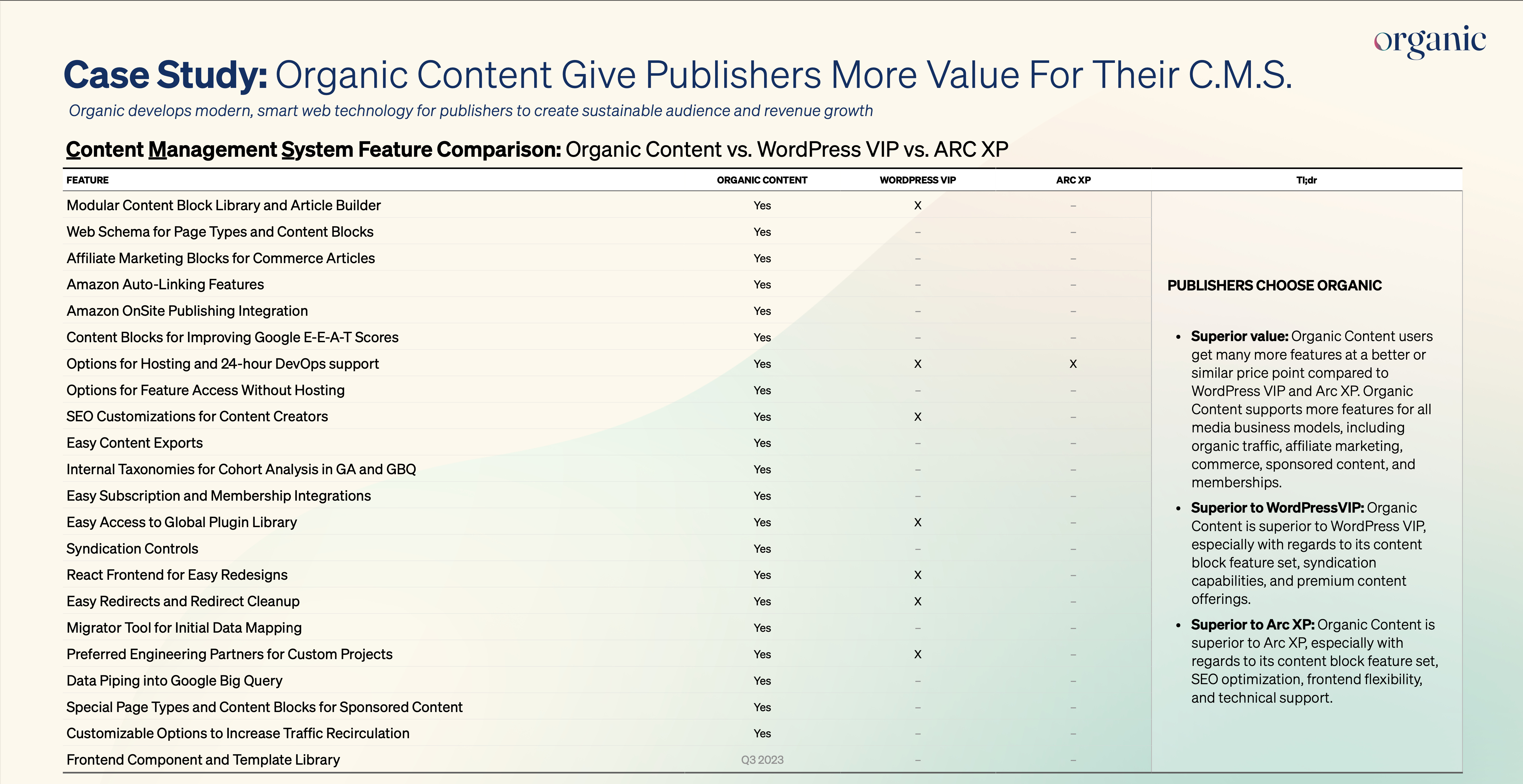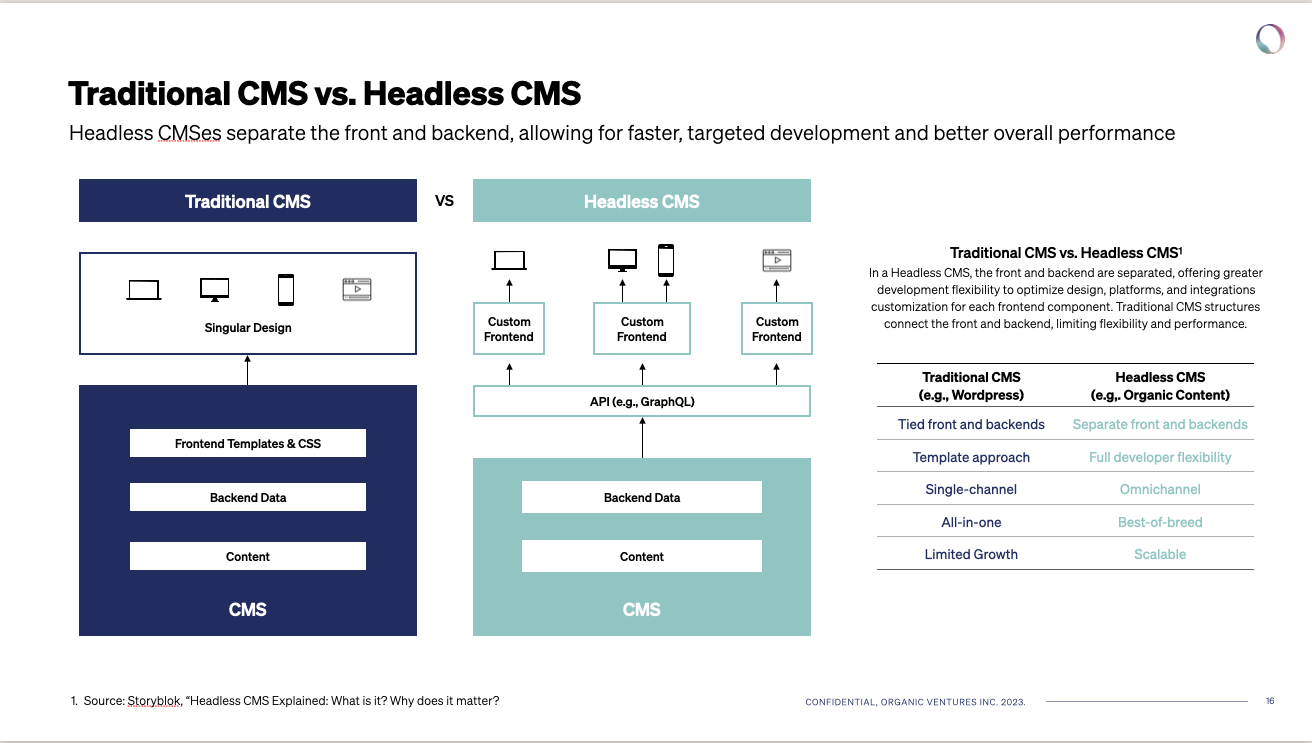Share this
Roadmap for Choosing the Right Enterprise Content Management Platform
by Organic Team on Jan 15, 2024 4:59:15 PM
Uncover the potential for audience and revenue growth by choosing the perfect enterprise content management platform.
Understanding the Importance of Enterprise Content Management
Enterprise content management is crucial for publishers with high volumes of monthly pageviews. It involves organizing, storing, and managing digital content efficiently. With a robust enterprise content management platform, publishers can streamline their workflow, improve collaboration among team members, and enhance the overall content creation and publishing process.
By understanding the importance of enterprise content management, publishers can leverage the power of technology to optimize their content strategy, drive audience engagement, and ultimately increase revenue.
Key Factors to Consider When Choosing an Enterprise Content Management Platform
When it comes to selecting an enterprise content management platform, publishers must take into account several crucial factors. Firstly, scalability of technical architecture is paramount. The platform should have the ability to handle a high volume of monthly pageviews without sacrificing performance or data compliance. Additionally, seamless integration with media-specific systems and tools is essential for efficient content management (high efficiency results in higher visibility via search and syndication rankings).
Another vital factor to consider is customization for the end user. Publishers should seek a platform that allows them to personalize the user interface, workflows, and permissions to meet their specific needs. Furthermore, prioritizing security and data protection ensures the safeguarding of valuable content and user data. For publishers, owning their own data is critical now more than ever given the importance of creatives' intellectual property vs. ai-generated content.
Lastly, publishers should assess the user-friendliness of the platform and the level of support services available. A user-friendly interface enhances productivity and reduces the learning curve for content creators. Adequate support services, including training and technical assistance, are vital for a smooth implementation process.
Exploring Different Types of Enterprise Content Management Platforms
There are various types of enterprise content management platforms available in the market. Each type offers unique features and functionalities to cater to different publisher needs. Some platforms focus on document management, providing efficient storage, retrieval, and version control of digital files.
Others emphasize web content management, offering tools for creating, editing, and publishing web pages. Digital asset management platforms specialize in organizing and distributing multimedia assets, such as images, videos, and audio files.
Publishers should carefully evaluate their requirements and choose a platform that aligns with their content management goals. A comprehensive understanding of the different types of platforms will ensure an informed decision.
Standardization to Grow Audience via SEO, Syndication, and Recirculation
Standardization plays a crucial role in audience growth for publishers. By implementing a robust enterprise content management platform, publishers can standardize their content creation process, ensuring consistency in formatting, metadata, and SEO optimization.
Standardization enables publishers to improve search engine visibility, attract organic traffic, and enhance user experience. Moreover, syndication and recirculation of standardized content across various platforms and channels can significantly expand the publisher's reach and increase audience engagement.
By leveraging the power of standardization, publishers can establish themselves as trusted sources of high-quality content, attracting a larger audience and driving revenue growth. The argument against standardization is lack of design flexibility. Those publishers are the ones who soon discover the benefits of looking into a headless CMS, as decoupling the front end and back end ensures you can design as much as needed without affecting the underlying data standardization driving the SEO, syndication, and other benfits.
Integrated Analytics to Increase Ads and Affiliate Earnings
An enterprise content management platform with integrated analytics capabilities offers publishers valuable insights into content performance, audience behavior, and revenue generation. By leveraging these analytics, publishers can optimize their content strategy, identify popular topics, and tailor their offerings to audiences' changing preferences.
Furthermore, integrated analytics enable publishers to track ad performance, identify high-converting placements, and optimize revenue from advertising. Additionally, affiliate earnings can be maximized by analyzing referral traffic and identifying successful affiliate partnerships.
Integrating analytics into the content management platform empowers publishers with data-driven decision-making, resulting in increased ad revenue and affiliate earnings.
Cost Savings of Implementing a Robust Enterprise Content Management Platform
Implementing a robust enterprise content management platform can result in significant cost savings for publishers. By centralizing content creation, storage, and distribution, publishers can eliminate duplication of efforts and reduce resource allocation.
Automation features, such as content scheduling, publishing workflows, and approval processes, streamline operations and reduce manual labor. Additionally, integration with other systems and tools eliminates the need for multiple subscriptions and reduces overall IT costs.
Moreover, efficient content management reduces the risk of errors, rework, and content inconsistencies, further saving costs associated with content revisions and corrections.
Overall, investing in a robust enterprise content management platform offers long-term cost savings and improved operational efficiency for publishers.
Best Practices for Successful Implementation Adoption and Fast Timelines
To ensure successful implementation and fast timelines, publishers should follow best practices when adopting an enterprise content management platform. Firstly, thorough planning is essential. Publishers should define their goals, evaluate their existing content workflows, and outline the desired outcomes of the implementation.
Next, effective change management is crucial. Publishers should communicate the benefits of the new platform to all stakeholders, provide training and support, and address any resistance or concerns.
Collaboration and cross-departmental involvement are also key. Involving representatives from different teams, such as editorial, marketing, and IT, ensures a holistic approach and a smooth transition.
Lastly, continuous monitoring and evaluation are necessary to identify areas for improvement and maximize the platform's potential. Regular feedback collection and performance analysis will enable publishers to fine-tune their content management processes and drive ongoing success.
By following these best practices, publishers can achieve a successful implementation adoption and fast timelines, unlocking the full potential of their enterprise content management platform.
Share this
- June 2024 (2)
- May 2024 (3)
- April 2024 (1)
- March 2024 (4)
- February 2024 (1)
- January 2024 (11)
- December 2023 (1)
- November 2023 (2)
- October 2023 (3)
- September 2023 (3)
- August 2023 (4)
- June 2023 (1)
- May 2023 (3)
- March 2023 (4)
- February 2023 (5)
- January 2023 (3)
- December 2022 (1)
- November 2022 (2)
- October 2022 (2)
- September 2022 (1)


